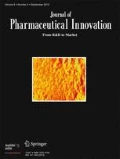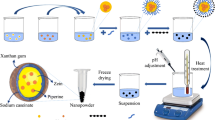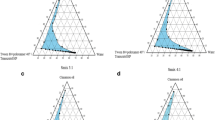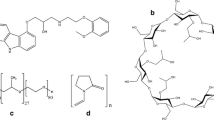Abstract
Purpose
Captopril is one of the most important angiotensin converting enzyme inhibitors and still the gold standard for the treatment of hypertension and congestive heart failure. However, it has a short duration of action and about 1–2 h biological half-life. Formulation of a sustained release dosage form of captopril is difficult due to its instability at the alkaline pH of the gastrointestinal tract. Therefore, incorporation of captopril within bioadhesive cubic nanoparticles or cubosomes could be an alternative way to improve its efficiency.
Methods
Monoolein dispersions containing captopril were prepared by the homogenization technique using different concentrations of monoolein and poloxamer. Characterization of these dispersions was performed by measuring particle size, small angle X-ray diffraction, cryo transmission electron microscopy, entrapment efficiency, and in-vitro release of captopril.
Results
Monoolein cubic nanoparticles with mean particle sizes between 250 and 350 nm were obtained after autoclaving the homogenized dispersions. The cubic structure was confirmed by the presence of the three characteristic X-ray diffraction peaks of P-type cubic phase and from cryo transmission pictures. A slow release of captopril from cubosomes was observed within 8 h with a high bioadhesion capacity where about 75% of these cubosomes adhered to stomach tissues.
Conclusion
Monoolein cubosomes could be used successfully as carriers for captopril where they slowly released it and had a good adhesion property to stomach tissues.









Similar content being viewed by others
References
Nur AO, Zhang JS. Captopril floating and/or bioadhesive tablets: design and release kinetics. Drug Dev Ind Pharm. 2000;26(9):965–9.
Schoenberger JA, Testa M, Ross AD, Brennan WK, Bannon JA. Efficacy, safety, and quality-of-life assessment of captopril antihypertensive therapy in clinical practice. Arch Intern Med. 1990;150(2):301–6.
Creasey WA, Morrison RA, Singhvi SM, Willard DA. Pharmacokinetics of intravenous captopril in healthy men. Eur J Clin Pharmacol. 1988;35(4):367–70.
Kayanakis JG, Baulac L. Comparative study of once-daily administration of captopril 50 mg, hydrochlorothiazide 25 mg and their combination in mild to moderate hypertension. Br J Clin Pharmacol. 1987;23(Suppl 1):89S-92S.
Guo JH, Cooklock KM. The effects of backing materials and multilayered systems on the characteristics of bioadhesive buccal patches. J Pharm Pharmacol. 1996;48(3):255–7.
Jones DS, Woolfson AD, Djokic J, Coulter WA. Development and mechanical characterization of bioadhesive semi-solid, polymeric systems containing tetracycline for the treatment of periodontal diseases. Pharm Res. 1996;13(11):1734–8.
Ponchel G, Irache J. Specific and non-specific bioadhesive particulate systems for oral delivery to the gastrointestinal tract. Adv Drug Deliv Rev. 1998;34(2–3):191–219.
Soane RJ, Frier M, Perkins AC, Jones NS, Davis SS, Illum L. Evaluation of the clearance characteristics of bioadhesive systems in humans. Int J Pharm. 1999;178(1):55–65.
Sankar C, Rani M, Srivastava AK, Mishra B. Chitosan based pentazocine microspheres for intranasal systemic delivery: development and biopharmaceutical evaluation. Pharmazie. 2001;56(3):223–6.
Chien YW. New developments in drug delivery systems. Med Res Rev. 1990;10(4):477–504.
Govender S, Pillay V, Chetty DJ, Essack SY, Dangor CM, Govender T. Optimisation and characterisation of bioadhesive controlled release tetracycline microspheres. Int J Pharm. 2005;306(1–2):24–40.
Huang JL, Lu JF. In vitro drug release profiles and mucoadhesive property of bioadhesive microspheres of metronidazole. Yao Xue Xue Bao. 2002;37(3):226–8.
Illum L, Fisher AN, Jabbal-Gill I, Davis SS. Bioadhesive starch microspheres and absorption enhancing agents act synergistically to enhance the nasal absorption of polypeptides. Int J Pharm. 2001;222(1):109–19.
Jha RK, Tiwari S, Mishra B. Bioadhesive microspheres for bioavailability enhancement of raloxifene hydrochloride: formulation and pharmacokinetic evaluation. AAPS PharmSciTech. 2011;12(2):650–7.
Ramdas M, Dileep KJ, Anitha Y, Paul W, Sharma CP. Alginate encapsulated bioadhesive chitosan microspheres for intestinal drug delivery. J Biomater Appl. 1999;13(4):290–6.
Shimoda J, Onishi H, Machida Y. Bioadhesive characteristics of chitosan microspheres to the mucosa of rat small intestine. Drug Dev Ind Pharm. 2001;27(6):567–76.
Upadhyay MS, Pathak K. Glyceryl monooleate-coated bioadhesive hollow microspheres of riboflavin for improved gastroretentivity: optimization and pharmacokinetics. Drug Deliv Transl Res. 2013;3(3):209–23.
Vasir JK, Tambwekar K, Garg S. Bioadhesive microspheres as a controlled drug delivery system. Int J Pharm. 2003;255(1–2):13–32.
Vyas SP, Jain CP. Bioadhesive polymer-grafted starch microspheres bearing isosorbide dinitrate for buccal administration. J Microencapsul. 1992;9(4):457–64.
Lai J, Chen J, Lu Y, Sun J, Hu F, Yin Z, et al. Glyceryl monooleate/poloxamer 407 cubic nanoparticles as oral drug delivery systems: I. In vitro evaluation and enhanced oral bioavailability of the poorly water-soluble drug simvastatin. AAPS PharmSciTech. 2009;10(3):960–6.
Sagalowicz L, Leser ME, Watzke HJ, Michel M. Monoglyceride self-assembly structures as delivery vehicles. Trends Food Sci Technol. 2006;17(5):204–14.
Wyatt DM, Dorschel D. A cubic-phase delivery system composed of glyceryl monooleate and water for sustained release of water-soluble drugs. Pharm Technol. 1992;16:116–30.
Yang D, Armitage B, Marder SR. Cubic liquid-crystalline nanoparticles. Angew Chem Int Ed. 2004;43(34):4402–9.
Drummond CJ, Fong C. Surfactant self-assembly objects as novel drug delivery vehicles. Curr Opin Colloid Interface Sci. 1999;4(6):449–56.
Gustafsson J, Ljusberg-Wahren H, Almgren M, Larsson K. Cubic lipid-water phase dispersed into submicron particles. Langmuir. 1996;12(20):4611–3.
Spicer PT, Hayden KL, Lynch ML, Ofori-Boateng A, Burns JL. Novel process for producing cubic liquid crystalline nanoparticles (cubosomes). Langmuir. 2001;17(19):5748–56.
Nielsen LS, Schubert L, Hansen J. Bioadhesive drug delivery systems. I. Characterisation of mucoadhesive properties of systems based on glyceryl mono-oleate and glyceryl monolinoleate. Eur J Pharm Sci. 1998;6(3):231–9.
Dawoud M, Abdou R. Ion exchange column technique as a novel method for evaluating the release of docetaxel from different lipid nanoparticles. Drug Deliv Transl Res. 2021.
D'Souza SS, DeLuca PP. Methods to assess in vitro drug release from injectable polymeric particulate systems. Pharm Res. 2006;23(3):460–74.
Shabbits JA, Chiu GNC, Mayer LD. Development of an in vitro drug release assay that accurately predicts in vivo drug retention for liposome-based delivery systems. J Control Release. 2002;84(3):161–70.
Washington C. Evaluation of non-sink dialysis methods for the measurement of drug release from colloids - effects of drug partition. Int J Pharm. 1989;56(1):71–4.
Washington C. Drug release from microdisperse systems: a critical review. Int J Pharm. 1990;58(1):1–12.
Washington C. Drug release from microparticulate systems. In: Drugs and Pharmaceutical Sciences. (Microencapsulation-Methods and Industrial Application) B, S., Ed., Marcel, D., New York,, editor. 1996;73.
Barauskas J, Johnsson M, Johnson F, Tiberg F. Cubic phase nanoparticles (Cubosome): principles for controlling size, structure, and stability. Langmuir. 2005;21(6):2569–77.
Hassan EE, Parish RC, Gallo JM. Optimized formulation of magnetic chitosan microspheres containing the anticancer agent, oxantrazole. Pharm Res. 1992;9(3):390–7.
Rango R, Barip K. A novel in situ method to test polymers and coated microparticles for bioadhesion. Int J Pharm. 1989;52:265–70.
Bernkop-Schnurch A, Weithaler A, Albrecht K, Greimel A. Thiomers: preparation and in vitro evaluation of a mucoadhesive nanoparticulate drug delivery system. Int J Pharm. 2006;317(1):76–81.
Boyd BJ. Characterisation of drug release from cubosomes using the pressure ultrafiltration method. Int J Pharm. 2003;260(2):239–47.
Fletcher AE, Bulpitt CJ, Hawkins CM, Havinga TK, ten Berge BS, May JF, et al. Quality of life on antihypertensive therapy: a randomized double-blind controlled trial of captopril and atenolol. J Hypertens. 1990;8(5):463–6.
Groel JT, Tadros SS, Dreslinski GR, Jenkins AC. Long-term antihypertensive therapy with captopril. Hypertension. 1983;5(5 Pt 2):III145–51.
Waeber B, Gavras I, Brunner HR, Cook CA, Charocopos F, Gavras HP. Prediction of sustained antihypertensive efficacy of chronic captopril therapy: relationships to immediate blood pressure response and control plasma renin activity. Am Heart J. 1982;103(3):384–90.
Hwang SJ, Park H, Park K. Gastric retentive drug-delivery systems. Crit Rev Ther Drug Carrier Syst. 1998;15(3):243–84.
Dawoud MZ, Nasr M. Comparison of drug release from liquid crystalline monoolein dispersions and solid lipid nanoparticles using a flow cytometric technique. Acta Pharm Sin B. 2016;6(2):163–9.
Hashem FM, Dawoud M. A new approach to investigate drug release from liquid crystalline monoolein dispersions. J Pharm Res. 2014;8(12):1757–63.
de Araujo SC, de Mattos AC, Teixeira HF, Coelho PM, Nelson DL, de Oliveira MC. Improvement of in vitro efficacy of a novel schistosomicidal drug by incorporation into nanoemulsions. Int J Pharm. 2007;337(1–2):307–15.
Thanoo BC, Sunny MC, Jayakrishnan A. Cross-linked chitosan microspheres: preparation and evaluation as a matrix for the controlled release of pharmaceuticals. J Pharm Pharmacol. 1992;44(4):283–6.
Clogston J, Caffrey M. Controlling release from the lipidic cubic phase. Amino acids, peptides, proteins and nucleic acids. J Control Release. 2005;107(1):97–111.
Clogston J, Craciun G, Hart DJ, Caffrey M. Controlling release from the lipidic cubic phase by selective alkylation. J Control Release. 2005;102(2):441–61.
Shah JC, Sadhale Y, Chilukuri DM. Cubic phase gels as drug delivery systems. Adv Drug Deliv Rev. 2001;47(2–3):229–50.
Guo C, Wang J, Cao F, Lee RJ, Zhai G. Lyotropic liquid crystal systems in drug delivery. Drug Discov Today. 2010;15(23–24):1032–40.
Dian L, Yang Z, Li F, Wang Z, Pan X, Peng X, et al. Cubic phase nanoparticles for sustained release of ibuprofen: formulation, characterization, and enhanced bioavailability study. Int J Nanomedicine. 2013;8:845–54.
Nguyen TH, Hanley T, Porter CJ, Boyd BJ. Nanostructured liquid crystalline particles provide long duration sustained-release effect for a poorly water soluble drug after oral administration. J Control Release. 2011;153(2):180–6.
Efrat R, Kesselman E, Aserin A, Garti N, Danino D. Solubilization of hydrophobic guest molecules in the monoolein discontinuous QL cubic mesophase and its soft nanoparticles. Langmuir. 2009;25(3):1316–26.
Engström S, Norden TP, Nyquist H. Cubic phases for studies of drug partition into lipid bilayers. Eur J Pharm Sci. 1999;8(4):243–54.
Yuan H, Miao J, Du YZ, You J, Hu FQ, Zeng S. Cellular uptake of solid lipid nanoparticles and cytotoxicity of encapsulated paclitaxel in A549 cancer cells. Int J Pharm. 2008;348(1–2):137–45.
Acknowledgement
The authors would like to thank the Deanship of Scientific Research at Umm Al-Qura University for supporting this work by Grant Code: 22UQU4350487DSR01
Author information
Authors and Affiliations
Contributions
Mohamed Dawoud: conceptualization, methodology, writing — original draft, investigation; Randa Abdou: methodology, resources — review and editing.
Corresponding author
Ethics declarations
Conflict of Interest
The authors declare no competing interests.
Additional information
Publisher's Note
Springer Nature remains neutral with regard to jurisdictional claims in published maps and institutional affiliations.
Rights and permissions
About this article
Cite this article
Dawoud, M., Abdou, R. Preparation and Characterization of Bioadhesive Monoolein Cubosomes as Carriers for Captopril. J Pharm Innov 18, 118–127 (2023). https://doi.org/10.1007/s12247-022-09618-0
Accepted:
Published:
Issue Date:
DOI: https://doi.org/10.1007/s12247-022-09618-0




